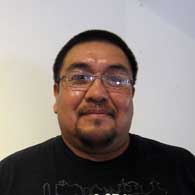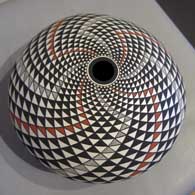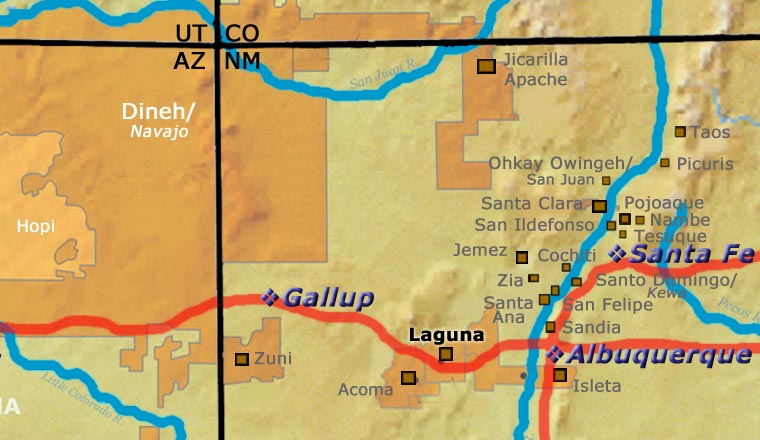
Robert Kasero
Sr.
Laguna

Born in 1969 to Henry and Marie Kasero, Robert Kasero Sr., is a potter from Laguna Pueblo. His heritage is half Laguna, half Hopi. Early in his creative career he was carving Hopi katsinas, his favorite being the Kwaakatsina (the Eagle katsina). His mother had been a participant in the Laguna Arts and Crafts Project in 1973 and learned how to make pottery from Evelyn Cheromiah. Robert says he learned some of the traditional way of making pottery from his mother and some on his own but it was after becoming Paula Estevan's significant other that he really came into his own with Clay Mother. Paula has had a strong influence on his styles and designs but she says she leaves the details in his capable hands.
Like her work, his pieces are very thin walled and precisely painted, generally featuring a single design element that is repeated in an extremely fine, almost laser-like progressive pattern across the entire surface of the pot. Robert focuses on creating large seed pots that resemble sea urchins and he occasionally adds a full neck. His favorite designs are geometric, laid out such that a swirl is a straight line is a checked pattern, and the whole is simply dazzling to the eye.
While their styles are similar, the two partners do not collaborate. Paula is so confident in his work that she "seldom makes suggestions."
Robert tells us he gets his inspiration from the two most important women in his life: his mother and Paula. He also really enjoys when we tell him stories from his pleased collectors. He signs his work: "R. Kasero Sr., Laguna, NM."
100 West San Francisco Street, Santa Fe, New Mexico 87501
(505) 986-1234 - www.andreafisherpottery.com - All Rights Reserved

Laguna Pueblo
After the Pueblo Revolt of 1680, the pueblos were fearful of Spanish reprisals. Spanish militias returned several times in the 1680s, looting and burning before returning to safety south of El Paso. In those years, when the Puebloans became aware of approaching Spanish forces they mostly scattered into the mountains and the Spanish found empty pueblos, easy to loot and easy to burn. When Don Diego de Vargas marched north in 1692, he was intent on reconquering Nuevo Mexico and re-establishing a long-term Spanish presence there. As the conquistadors who accompanied him were on a "do-or-die" mission, the reconquest took on a tenor quite different from the previous missions...
At first de Vargas followed a path of reconciliation with the pueblos but that was soon replaced with an iron fist that brought on a second revolt in 1696. The pueblos didn't fare so well the second time around and a large number of Pueblo warriors were executed while their wives and children were forced into slavery. When word of de Vargas actions got back to the King of Spain, he ordered de Vargas banned from the New World. However, most of the damage was already done.
Many modern historians say Laguna Pueblo was established between 1697 and 1699 by refugees seeking to avoid the fighting with the Spanish. Many of those refugees had left the first pueblos approached by the Spanish in 1692. Most had scattered to more remote places like Acoma, Zuni and Hopi, or to more Spanish-friendly Isleta. However, the pressure of those refugees strained the resources of the other pueblos and quickly forced the refugees to consider starting a new existence in a newly-formed pueblo.
In the 1000s CE, groups of Keres-speaking people were migrating out of the Chaco Canyon area. Some went to the south around the west side of Mount Taylor (and eventually to Acoma), and some went around the east side. Those who went around the east side of the ancient volcano came to a large lake where they decided to settle. The number of abandoned pueblos in the area says they stayed close to that lake for many years, moving only as drought and exhausted soils forced them to. That lake is what caused the Spanish to name the village "Laguna" several hundred years later. Some of the land under Laguna control has also been found to contain archaeological resources dating as far back as 3,000 BCE.
On the east side of today's Laguna Reservation is where the Puerco River of the East flows. There were numerous pueblos established along the Puerco between about 1250 and 1450 CE. Among them was a village now named Pottery Mound, named for the massive mounds of potsherds in and around the ruin. Pottery Mound was abandoned before the Spanish first arrived but archaeologists have followed the tracks left by Pottery Mound styles, shapes and designs to Acoma, Zuni and to settlements in the Hopi mesas and the Four Corners area.
In the 1700s, several villages were established in the area around Old Laguna and when the Lagunas were granted their own reservation, they were given about 500,000 acres of land, making Laguna one of the largest of all pueblos in terms of land. However, only about half the enrolled members of the tribe live at Laguna as many have been drawn to nearby Albuquerque in search of work.
Laguna and Acoma share the same language (Western Keres), similar pottery styles and similar religious beliefs. However, pottery making almost died out at Laguna after the railroads arrived in New Mexico in 1880 and laid a primary east-west trackbed directly in front of the Laguna main pueblo. During that time period many Lagunas went to work on railroad construction crews and many of the traditional Laguna arts and crafts died out. It didn't help when a Methodist missionary was elected pueblo governor in 1872. Among his first steps in office was an order to destroy all the kivas on Laguna land. That caused a schism in the tribe and, shortly, about half the Lagunas left their reservation and relocated to Isleta. Many of them returned to Laguna years later but there are still some at Isleta.
Pottery making never completely stopped at Laguna but by 1960 it was almost gone. Then in 1973 and again in 1974 Nancy Winslow (an Anglo woman from Albuquerque) taught two four-month arts and crafts classes at the pueblo. Among the 22 pueblo members in the first class were Evelyn Cheromiah and her daughters. Rick Dillingham quoted Evelyn Cheromiah as saying that after "looking at my mother's pottery-making tools, I got the urge of going back to making pottery." That was the beginning of today's renaissance in Laguna pottery.
Because of their geographic proximity, Laguna and Acoma clays are very similar, although Laguna clay tends to be a bit more sandy. In some instances, it's very hard to determine if a particular pot is from Acoma or from Laguna. Laguna potters are more likely to temper their white clay with sand than with ground potsherds like the Acomas do. Laguna geometric designs also tend to be bolder than Acoma designs while Laguna potters use Mimbres designs much more sparingly than do Acoma potters.
100 West San Francisco Street, Santa Fe, New Mexico 87501
(505) 986-1234 - www.andreafisherpottery.com - All Rights Reserved

Evelyn Cheromiah Family and Teaching Tree
Disclaimer: This "family tree" is a best effort on our part to determine who the potters are in this group and arrange them in a generational order. The general information available is questionable so we have tried to show each of these diagrams to living members of each family to get their input and approval, too. This diagram is subject to change should we get better info.
Evelyn worked with Nancy Winslow, an Anglo woman from Albuquerque, to set up what became the 1973 Laguna Arts and Crafts Project. At that time, only Evelyn and a couple potters in the village of Mesita were still making Laguna pottery. Those women were teaching their daughters, too, but it was clearly a dying art. Evelyn and Nancy secured enough funding for Evelyn to teach two 4-month sessions of pottery making classes. Both groups were filled to overflowing.
- Josephita Cheromiah
- Elton Cheromiah (1975- )
- Lee Ann Cheromiah (1954- )
- Brooke Cheromiah
- Mary W Cheromiah Victorino (c. 1950s- )
- Wendy Cheromiah Kowemy
- Wendell Kowemy (1972- )
- Velma Analla & Calvin Analla Sr.
- Calvin Analla Jr. (1958- )
- Elsie Chereposy
- Marie Kasero
- Robert Kasero Sr. & Paula Estevan (Acoma)
- Mabel Poncho (c. 1920s- )
- Sue Tapia (1945- ) & Tom Tapia (1946-2015, Ohkay Owingeh)
- Matt Valencia
- Patrick Valencia
- Sue Tapia (1945- ) & Tom Tapia (1946-2015, Ohkay Owingeh)
- Bertha Riley (Evelyn's niece) & Stuart Riley Sr. (Dineh)
- Stuart Riley Jr.
Some of the above info is drawn from Southern Pueblo Pottery, 2000 Artist Biographies, by Gregory Schaaf, © 2002, Center for Indigenous Arts & Studies. Other info is derived from personal contacts with family members and through interminable searches of the Internet and cross-examination of the data found.
(505) 986-1234 - www.andreafisherpottery.com - All Rights Reserved
